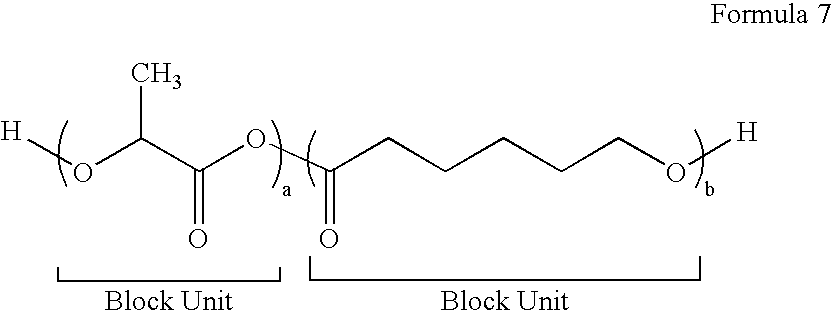Block Biodegradable Copolymers for Medical Devices
a biodegradable, medical device technology, applied in the field of medical devices, can solve the problems of increasing the problem, affecting the quality of medical devices, and the prior art method of developing polymer coatings, specifically drug-eluting coatings, has been largely by trial and error
- Summary
- Abstract
- Description
- Claims
- Application Information
AI Technical Summary
Benefits of technology
Problems solved by technology
Method used
Image
Examples
example 1
[0066]To a 25 mL glass serum bottle, 0.04 g of tin (II) 2-ethylhexanoate, 0.0146 g of 1,8-octanediol and 3 g of ε-caprolactone was added in a dry box. The bottle was capped and taken out of the dry box. The polymerization was carried out in an oil bath at 110° C. for 8 hrs. Then the bottle was brought back into the dry box and 7 g of lactide was added into the bottle, the bottle was resealed and then taken out of the dry box. The reaction was continued at 110° C. for an additional 12 hrs before being stopped by adding a few drops of methanol. The crude product was dissolved in chloroform, precipitated in methanol twice, collected and dried in vacuum oven to form Polymer 4 (Table 1).
example 2
[0067]To a 25 mL glass serum bottle, 0.04 g of tin (II) 2-ethylhexanoate, 0.0146 g of 1,8-octanediol and 3 g of cyclohexyl caprolactone is added in a dry box. The bottle is capped and taken out of the dry box. The polymerization is carried out in an oil bath at 110° C. for 8 hrs. Then the bottle is brought back into the dry box and 7 g of lactide is added into the bottle, the bottle is resealed and then taken out of the dry box. The reaction is continued at 110° C. for an additional 12 hrs before being stopped by adding a few drops of methanol. The crude product is dissolved in chloroform, precipitated in methanol twice, collected and dried in vacuum oven.
example 3
[0068]To a 25 mL glass serum bottle, 0.04 g of tin (II) 2-ethylhexanoate, 0.0146 g of 1,8-octanediol and 3 g of glycolide is added in a dry box. The bottle is capped and taken out of the dry box. The polymerization is carried out in an oil bath at 110° C. for 8 hrs. Then the bottle is brought back into the dry box and 7 g of lactide is added into the bottle, the bottle is resealed and then taken out of the dry box. The reaction is continued at 110° C. for an additional 12 hrs before being stopped by adding a few drops of methanol. The crude product is dissolved in chloroform, precipitated in methanol twice, collected and dried in vacuum oven.
PUM
| Property | Measurement | Unit |
|---|---|---|
| Mass | aaaaa | aaaaa |
| Mass | aaaaa | aaaaa |
| Mass | aaaaa | aaaaa |
Abstract
Description
Claims
Application Information
 Login to View More
Login to View More - R&D
- Intellectual Property
- Life Sciences
- Materials
- Tech Scout
- Unparalleled Data Quality
- Higher Quality Content
- 60% Fewer Hallucinations
Browse by: Latest US Patents, China's latest patents, Technical Efficacy Thesaurus, Application Domain, Technology Topic, Popular Technical Reports.
© 2025 PatSnap. All rights reserved.Legal|Privacy policy|Modern Slavery Act Transparency Statement|Sitemap|About US| Contact US: help@patsnap.com



